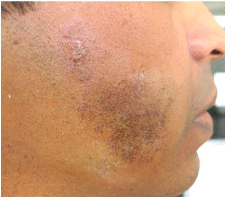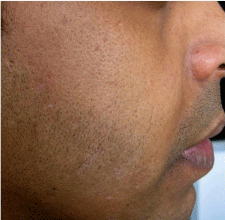
Case Report
Austin J Clin Case Rep. 2015;2(1): 1064.
Allergic Contact Dermatitis of Face Following use of Household Detergent Soap
Gayathri Ramesh1, Manjunath BS2*, Ramesh Nagarajappa3 and Ashish Sharma4
1Department of Oral and Maxillofacial Pathology, Rama Dental College and Hospital, India
2Department of Oral and Maxillofacial Pathology, KM Dental College&Hospital, India
3Department of Public Health Dentisty, Rama Dental College and Hospital, India
4Department of Oral and Maxillofacial Pathology, Bhabha College of Dental Sciences, India
*Corresponding author: Manjunatha BS, Department of Oral and Maxillofacial Pathology, KM Dental College & Hospital, Vadodara India
Received: July 05, 2014; Accepted: January 08, 2015; Published: January 12, 2015
Abstract
Allergic Contact Dermatitis (ACD) is a delayed type of induced sensitivity (allergy) resulting from cutaneous contact with a specific allergen to which the patient has developed a specific sensitivity. This allergic reaction causes inflammation of the skin manifested by varying degrees of erythema, edema, and vesiculation. No diagnostic test exists for this. The diagnosis rests on the exclusion of other cutaneous diseases and on the clinical appearance skin at a site sufficiently exposed to a known cutaneous irritant. A case of ACD in a male patient of aged about 25 years who reported to the clinic with a chief complaint of redness and itching on right lateral region of the face since a day.
Introduction
Detergents are used by almost every household in the developed and developing world. The resultant eczema, predominantly localized to the hands following irritation, is very distressing and incapacitating. Females working with detergents at home and in occupations involving exposure to such detergents bear the brunt [1].
In spite of advertising claims of relative mildness of a particular detergent powder, most of these patients are likely to be atopic who have defective barrier function and thus are more prone for skin irritation [2]. Anionic surfactants, an active ingredient of detergents make the water more effective when cleaning, but act by increasing the permeability of horny layer of the skin and with little or no inflammatory change leads to severe scaling without much erythema, disrupting the stratum corneum barrier function and finally end up in dermatitis [1,3].
Case Report
A male patient aged 25 years reported to the clinic with a chief complaint of redness and itching on right lateral region of the face since one day. He gave a history of cleaning the same area with detergent soap to remove Holi (Indian festival of colors) color stain which was not getting washed off otherwise. The detergent was reported to be consecutively used twice to remove the stain (color). After 30 min of washing he felt burning and itching sensation in the same area. On inspection brownish to reddish rashes in the background of white scaly skin with slight swelling was noted extending about 3x2cms on the right lateral aspect of the face (Figure 1). Based on patients' history and clinical features a diagnosis of allergic contact dermatitis was made. Patient was advised to avoid washing with soap for few days and apply mild moisturizer on the affected area and was recalled for follow up after a week. On examination the affected area was completely healed without any scars (Figure 2).

Figure 1: Photograph showing the brownish to reddish rashes on the right
lateral aspect of the face.

Figure 2: Photograph showing completely healed area.
Discussion
Objective skin signs like erythema, scaling, fissures, and subjective symptoms like itching, dryness, and smarting occur when there is increase in trans-epidermal water loss after exposure to detergents.
The anionic surfactants shows a hallmark of damage i.e. "chapping" with a roughened, dry, cracked ruddy surface most evident on the hands, where the horny layer is thick [4]. According to Schmid et al. [5] pH of the skin follows a sharp gradient across the stratum corneum, which is suspected to be important in controlling enzymatic activities and skin renewal which is affected by a great number of endogenous and exogenous factors like skin moisture, sweat, sebum, anatomic site, genetic predisposition and age, detergents, application of cosmetic products, occlusive dressings as well as topical antibiotics. Changes in pH are reported to play a role in the pathogenesis of skin diseases like irritant contact dermatitis, atopic dermatitis, ichthyosis, acne vulgaris and Candida albicans infections. Thus the irritancy of a soap or detergent is a product of its inherent irritancy and its weakening of the barrier [4].
Therefore, the use of skin cleansing agents, especially synthetic detergents with a pH of about 5.5, may be of relevance in the prevention and treatment of such skin diseases [5]. The alkalinity of a detergent determines how friendly or harsh it is going to be to the skin. The higher the alkalinity (pH), the more danger the detergent will be and rough on hands and will also erode the fabric of the clothes being washed [6].
In addition to increasing permeability, the high pH of the detergent also contributes to the detergent-induced irritant effect. The skin surface is slightly acidic, giving the concept of acid mantle. The 'acid mantle' of the stratum corneum seems to be important for permeability, barrier formation, and cutaneous antimicrobial defense.5 Thus, an important indicator of a cleanser or detergent's irritant potential is its pH.
Though investigations on detergent-induced skin irritation have been limited, irritant potential of soaps / cleansers in the Indian market with a 24-hour patch test has been reported [1,2]. Doctors are frequently confronted with the question from patients suffering with chronic hand eczema "which detergent powder or detergent cake should I use?", but mere prescription of a detergent powder or cake does not convince these patients on its suitability and compatibility on their skin [1].
The primary prevention and treatment for contact dermatitis is simple avoidance of the causative agent. Once contact dermatitis is diagnosed, antiseptic hand creams and protective lotions should be used to reduce the number of microorganisms on the skin as well as the risk of shedding these organisms. For the majority of health care workers this is simply not possible - frequent hand washing with an anti-microbial soap and glove use are required practices for effective infection control [7].
According to Korting et al. [8] pH of skin seems to be open to long-standing changes occurring due to repeated washings with soap and synthetic detergents which may also be of major influence on the composition of the cutaneous bacterial flora.
When prescriptions are required, topical corticosteroid creams are typically prescribed. In severe cases, an oral corticosteroid may be used for a short time [7].
Summary and Conclusion
Household detergents are used may have adverse effects as eczema, predominantly localized to the hands following irritation, is very distressing and incapacitating. The primary prevention and treatment for contact dermatitis is simple avoidance of the causative agent. The case of presented here reported with a chief complaint of redness and itching on right lateral region of the face of one day caused by a detergent soap used to clean the area remove colors during playing Holi festival (Indian festival of colors).
References
- Austoria AJ, Lakshmi C, Srinivas CR, Anand CV, Mathew AC. Irritancy potential of 17 detergents used commonly by the Indian household. Indian J Dermatol Venereol Leprol. 2010; 76: 249-253.
- Lakshmi C, Srinivas CR, Anand CV, Mathew AC. Irritancy ranking of 31 cleansers in the Indian market in a 24-h patch test. Int J Cosmet Sci. 2008; 30: 277-283.
- Scheuplein R, Ross L. Effects of surfactants and solvents on the permeability of epidermis. J Soc Cosmet Chem. 1970; 21: 853-873.
- Bettley FR. Some effects of soap on the skin. Br Med J. 1960; 1: 1675-1679.
- Schmid-Wendtner MH, Korting HC. The pH of the skin surface and its impact on the barrier function. Skin Pharmacol Physiol. 2006; 19: 296-302.
- Detergents: A bucket-full of dirty water. Consumer VOICE magazine. 2008.
- Contact Dermatitis: A major occupational health problem.
- Korting HC, Kober M, Mueller M, Braun-Falco O. Influence of repeated washings with soap and synthetic detergents on pH and resident flora of the skin of forehead and forearm:Results of a cross-over trial in health probationers. Acta Derm Venereol. 1987; 67: 41-47.